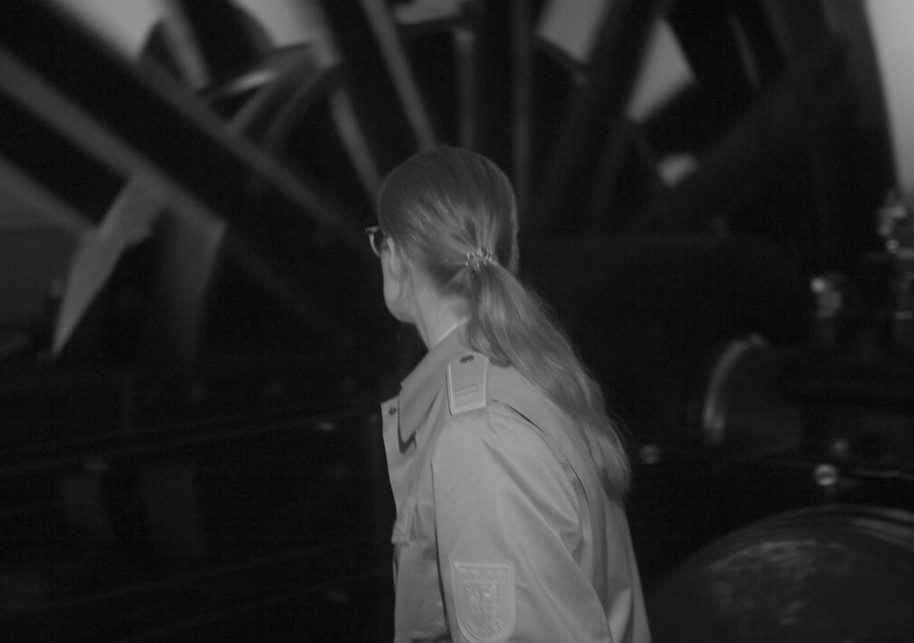Night Work: On Melanie Manchot’s Liquid Skin
The Film London Jarman Award 2024Mimi Howard

Melanie Manchot & Andrew Schonfelder, Liquid Skin (2023), film still. Commissioned by Urbane Künste Ruhr. Courtesy Galerie m, Bochum, Germany
Melanie Manchot’s 23-minute film Liquid Skin (2023) takes place across several sites in the Ruhr region of Germany: a bakery, a club, an auditorium, a villa. Clustered atop coalfields east of the Rhine, the Ruhr valley became essential to West German economic recovery after the Second World War. By the early 1980s, as in the Rustbelt in America or the Midlands, post-war boom (the so-called Wirtschaftswunder or ‘Miracle on the Rhine’) gave way to bust. Growth stagnated, workers were laid off, deindustrialisation tore through cities in the region. Yet, the frozen infrastructures of industry persisted, abandoned and empty – cathedrals of capital’s ambitions and its past lives.
With its opening sequence, Liquid Skin takes these imposing, vestigial sites as its object of examination. Emerging outside of a derelict factory, the camera follows a woman in a white coat into an old engine room covered with graffiti (‘Fuck the Police’ is visible in one corner). Heavy industrial equipment blocks our view of her as the camera curves around a bend, before re-focusing upon the woman, now de-robed and joined by a dance partner swivelling around a pole. She swings off it and continues downwards into a labyrinth of outdoor passageways. It’s a jolting, potent image. Skin and metal: a juxtaposition of the supposed most feminine and most masculine of trades.
If we live in cities (Liverpool or London, Dortmund or Detroit), we are accustomed to the variety of means deployed so that places such as these get refashioned to new ends – factories are turned into clubs, mansions of industrial barons into museums, granaries into luxury lofts. (In financial terms, ‘liquidity’ refers to an object’s capacity to be converted into money). As Manchot suggests, the character and category of labour itself has transmogrified in the twenty-first century, too. In the Ruhr’s heyday, it was male workers who were the protagonists of post-war West German economic recovery, spotlit for their work in the coal mines and steel factories. In Liquid Skin, Manchot instead turns her focus to a set of unlikelier protagonists lurking in the shadows: night labourers.

Melanie Manchot & Andrew Schonfelder, Liquid Skin (2023), film still. Commissioned by Urbane Künste Ruhr. Courtesy Galerie m, Bochum, Germany
After putting out a call for women night workers, Manchot drew responses from a baker, bouncer, wrestler, pole dancer, firefighter, tram driver, nurse, cleaner, bar worker, and engineer. (In other words, women primarily employed in the so-called ‘non-productive’ or service industries.) The cast was deeply involved with the production process, co-creating the shots and their movements with the director. A similar strategy was deployed in Manchot’s feature-length film STEPHEN (2023), born out of years working with a real-life Liverpool recovery group. In the opening scene, Stephen Giddings plays himself as he auditions for a film about a gambling addict, the Victorian-era criminal Thomas Goudie, subject of the first crime re-enactment film Arrest of Goudie (1901). It is less a deconstruction of the borderlines between fiction and reality than it is a continual test of their porousness.
In Liquid Skin the effect achieved by working with non-professional actors, women playing themselves, is somewhat different. Without the use of typical documentary techniques like talking heads, interviews, or indeed speech in any form, we are placed within a realism that is fringed with a surreality – a quasi-sleepwalking state. The phantasmagorical feeling in Liquid Skin is enhanced by Manchot’s aesthetic choices. Shot in infrared, and displayed in black and white, the film’s subjects shine brightly against the shadows of these hulking buildings. They walk through their workspaces hauntingly – with familiarity, fondness, and an ironic sense of proprietorship. They are definitively not the owners of these buildings, but they are nonetheless their guardians: their hands graze across bannisters, shift something back into place, tap the ceiling as they walk downstairs.
In each of the ten sequences, Manchot’s camera follows its protagonists via long shots (no cuts or edits) as they move through their cavernous worksites. The durational advantage of the long shot is that our eyes can wander across the physical space; attention is drawn to the magnitude of industry’s aspirations: tall ceilings, neoclassical design, a sprawl of interconnected factories. Manchot’s use of the tracking shot, whereby a subject’s movements are followed by the camera, is a winking reversal of its role in cinema’s history. Often meant to underscore activity and masculinity, as in the films of Martin Scorsese, Orson Welles, or Quentin Tarantino, its function here is almost inverted. Manchot’s tracking shot emphasizes the women’s interiority amid quiet, still environments. A contemplative mood is bolstered by the sound design with echoing, dripping, and phantom noise from the outside (rain, cheers from a football field, singing).
Liquid Skin
is structured around these displacements: outside leaks inside, night bleeds into day, traditionally masculine work is feminized (there’s a dancer’s pole on the factory floor!). The scrambling of place, time, and identity is a reminder of how capital evaporates and confuses those categories in the first place. In his writings on the working-day, Karl Marx – a newspaper writer in the Ruhr region during the 1820s and 30s – continually returned to the subject of night work. For Marx, night labour was a case study in how capitalism tended to disaggregate categories formerly perceived as natural. ‘After capital had taken centuries in extending the working day to its maximum limit, and then beyond it,’ he wrote, ‘all bounds of morals and nature, age and sex, day and night, were broken down’.1 Liquid Skin, without didacticism, thematizes and interprets this breakdown by bringing the character of night work, and the people who perform it, into light.
1 Karl Marx, ‘Chapter 10: The Struggle for a Normal Working Day’, in Capital, vol. 1 (London: Penguin, 1976), pp. 389-90.
Mimi Howard is a writer and critic based in NYC. Her writing has appeared in Art Monthly, ArtReview, Another Gaze, boundary 2 review, Parapraxis, Radical Philosophy, and Los Angeles Review of Books. She holds a PhD from the University of Cambridge in History of Political Thought and is currently a postdoctoral ACLS Leading Edge Fellow.



